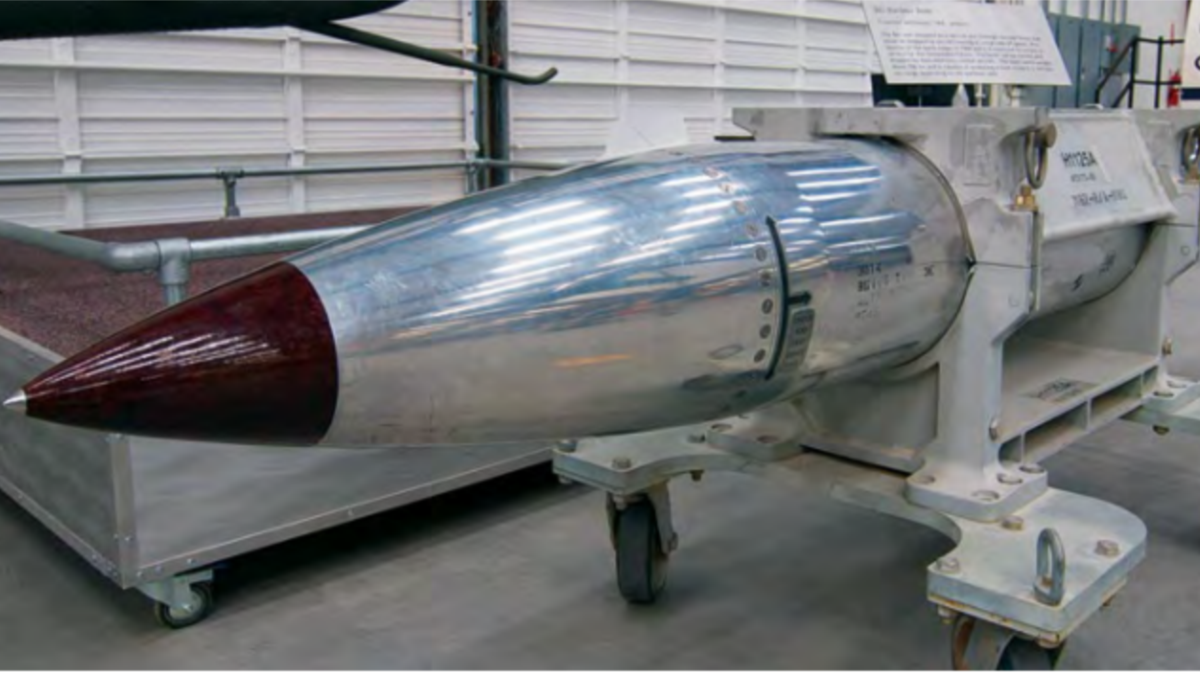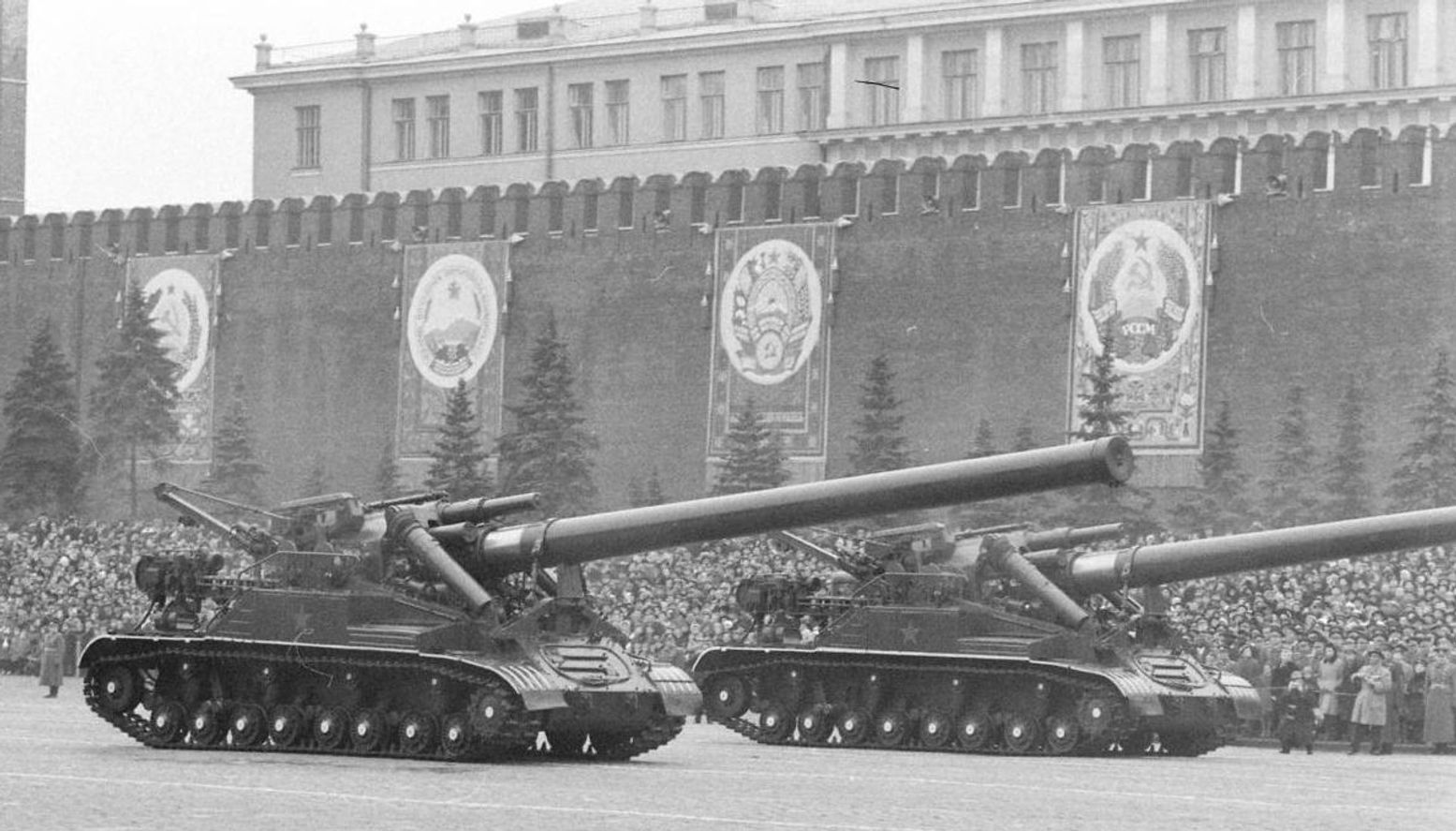Nuclear Artillery Shell - The W82 (also known as the XM785 shell) is a low-yield tactical nuclear warhead developed by the United States and designed for use in a 155 mm artillery shell. It was designed as a flexible replacement for the previous generation 155mm nuclear artillery shells for the W48. An earlier attempt to replace the W48 with W74 ammunition was abandoned due to cost.
Originally envisioned as a dual-purpose weapon, with components allowing the shell to function as either a standard fission detonator or a modified radiation device, the warhead was developed at Lors Livermore Laboratory.
Nuclear Artillery Shell
Since 1977. The prototype event yielded 2 ct (8.4 TJ) in a 34-inch (860 mm) package, weighing 95 pounds (43 kg),
The 10 Most Ridiculously Awesome Artillery Weapons Ever Used
Which included the rocket-assisted portion of the projectiles. The unit cost of the weapon was estimated at $4 million.
Although modified radiation devices were considered more effective at mitigating an attack due to the neutron flux they produced, the more complex design ultimately led to the cancellation of the dual-purpose W-82-0 program in 1982. Development of the weapon standard, W-82-1, was restarted in 1986. The program was canceled in 1991 due to the Cold War.
The case uses a titanium body and a rotating copper strip. A special process was developed to attach the rotating band to the titanium body of the case.0.1 to 1.1 kiloton TNT (0.42 to 4.60 TJ) (Mode 0), 0.8 kiloton TNT (3.3 TJ) (Mode 1)
(203 mm) was an American nuclear artillery shell capable of firing any 8 rounds from a NATO howitzer. howitzer M115 and M110.
Russia Destroyed Howitzer Used To Shell Zaporizhzhia Nuclear Plant: Ministry
Produced in two designs, the W79 Mod 0 with modified radiation and the W79 Mod 1 with fission only. Both were linear implosion nuclear weapons based on plutonium.
Both models were 8 in (203 mm) in diameter, 44 in (1100 mm) in length and weighed 200 lb (91 kg). W79 has been developed since 1975 by Lawrence Livermore National Laboratory. Production ran from July 1981 to August 1986 in various modes. A total of 550 warheads were produced (325 Mod 0, 225 Mod 1).
All units were withdrawn from active service in 1992, and the last hull was dismantled in August 2002 at the Pantex plant in Texas.

The weapon used the M735 close range fire. It had a dual channel fuze system, ssor target, electronic programmer and power supply.
Battleships Firing 'nuclear Bomb' Artillery Shells: The Navy's Wild Idea
Its design goals were to reduce overall weight, reduce structural bulk, eliminate the use of potting materials for structural support, and eliminate cables and wires.
The missile was developed with an extensive test program and during use, the 10,400 g Upshot - Knothole Grable, would have been a nuclear artillery projectile tested at the Nevada Test Site in 1953 (photo shows a 280 mm artillery piece). (11) and an artillery shell burst at a range of 10 km (6.2 mi)
Nuclear artillery is a subset of tactical nuclear weapons of limited success, particularly ground-launched weapons against battlefield targets. Nuclear artillery is usually associated with cannon-delivered projectiles, but short-range artillery rockets or tactical ballistic missiles are also included in the arsenal.
The development of nuclear artillery was part of a broader push by nuclear-armed nations to develop nuclear weapons that could be used tactically against enemy forces on the ground (as opposed to strategic use against cities, military bases, and heavy industry). Nuclear artillery was developed and deployed by a small group of states, including the United States, the Soviet Union, and France. The UK partially planned and developed such weapon systems (the Blue Water missile and the Yellow Anvil artillery shell), but did not manufacture them.
Amid 'concerns' Over Alleged Russian Threat, The World Overlooks The Real Danger
A second group of states has a generative association with nuclear artillery. These countries sent artillery units trained and equipped to use nuclear weapons, but did not control the devices themselves. Instead, the instruments are held by guardians stationed in developing countries. These custody units controlled the nuclear weapons until they were released for use in a crisis. This second group included the North Atlantic Treaty Organization (NATO) countries, including Belgium, Canada, West Germany, Greece, Italy, the Netherlands, Turkey and the United Kingdom.
Today, nuclear artillery has been replaced by the mobile tactical ballistic missile, a missile with a nuclear warhead.
US development led to nuclear weapons for various artillery systems. After the short-lived M65 nuclear cannon, standard howitzers were used. Delivery systems in approximate order of development:

The first artillery test took place on May 25, 1953 at the Nevada Proving Ground. Opshot - Fired and coded Shot GRABLE as part of the aircraft operation, the 280 mm (11 in) shell was fired 10,000 m (6.2 mi) through the cannon hole and detonated 160 m (525 ft) above the ground. estimated yield is 15 kilotons.
Putin Shows Off Nuclear Artillery Weapon That Can Destroy Targets 35 Miles Away
It was the only nuclear artillery shell fired as part of the US nuclear weapons testing program. The ship is 1,384 mm (4.5 ft) long and weighs 365 kg (805 lb). It was fired from a special, very large artillery piece, nicknamed "Atomic Annie," built by the Ordnance Test Division at Fort Sill, Oklahoma. About 3,200 soldiers and civilians. The warhead was designated the W9 nuclear warhead and 80 were produced for the T-124 warhead between 1952 and 1953. It was taken in 1957.
Development continued and resulted in the W19, a 280mm case, a longer version of the W9. Only 80 warheads were produced and the system was replaced by the W48 warhead in 1963.
The W48 is 846 mm long and weighs 58 kg; it was to fire the M-45 155mm AFAP (Artillery Fired Atomic Project) standard 155mm howitzer. The explosion casing was a type of linear impoundment consisting of a long cylinder of critical critical material that was compressed by the explosive and formed into a critical critical shape. The W48 explosive power produced 100 tons of TNT.
The W48 wt was produced in 1963 and 135 rounds of the Mod 0 version were produced until 1968 when it was replaced by the Mod-1. The Mod 1 was produced from 1965 to 1969. Of these, 925 were produced.
Russia Deployed 203mm Howitzer Firing Nuclear 3bv2 Shells
Other than the W48, only one type of artillery round was mass produced. It was a W33 nuclear warhead for use in an 8 inch (203 mm) diameter artillery shell. About 2,000 of these warheads were produced between 1957 and 1965. Each XM422 projectile was 940 mm long and weighed 243 pounds. The XM422s are equipped with a three-stage mechanical time-base rocket. If these weapons were to be used, they would have to be fired from an eight-inch howitzer.
The W33 quadruple yield was higher than the W48. The M422 project was hand-assembled in the field to ensure the desired yield, with three producing 5-10 kilotons and one 40-kiloton. There is also a ballistically compatible sighting system (HES M424) and a special white pouch loading system, the M80, which consists of one to three charges. M423 training rounds and their associated "bird cages" are on display at the National Atomic Museum in Albuquerque, New Mexico.
Efforts were made to modernize the warheads: the 155 mm W74 and 203 mm W75 were developed from about 1970 and the yield was supposed to be 100 tons or more. These versions were canceled in 1973.

Another development program began in the 1980s: W82, for the XM-785 (155 mm case), improved radiation capability up to two kilotons. Its development was stopped in 1983. A W82-1 fission type was developed but was canceled in 1990.
The Soviet 420 Mm Self Propelled Nuclear Heavy Artillery In Preparation For The Parade In Moscow, 1962
Other developments continued. In 1958, the UCRL Swift fusion warhead was developed and tested. Length 622 mm, diameter 127 mm, weight 43.5 kg. In testing it delivered only 190 tons; it failed to achieve fusion and only the initial cleavage functioned properly. There are unconfirmed reports that work on similar concepts continued into the 1970s and resulted in a one-pound 5-inch (127 mm) naval gun design; these, however, were never deployed as operational weapons.
In 1991, the United States unilaterally retired its nuclear artillery shells, and Russia responded in 1992. The United States removed about 1,300 nuclear warheads from Europe and dismantled the last one in 2004.
The Soviet Union's nuclear artillery is controlled by the missile forces and the artillery division of the Soviet ground forces. It was organic for tank and motorized rifle divisions and higher echelons. Control and protection of nuclear weapons was the responsibility of the 12th Main Directorate of the Ministry of Defense and its special departments.
The Soviet Union eventually developed and deployed missile and nuclear artillery systems. The first system developed was the SM-54 (2A3) 406 mm gun, nicknamed "Kondsator" (Russian: Конденсатор, "Конденсатор"); This was done in 1956. In 1957, a 420 mm self-propelled mortar, the 2B1 Oka or "Transformator" (Russian: Трансор морор; "Transformer") was produced. Tests revealed critical operational flaws in both systems and they were not fully produced. Specially designed weapon damaged
Russian Atomic Cannons Move Closer To Ukraine's Border
Artillery shell ashtray, civil war artillery shell, artillery shell lamp, ww1 artillery shell, artillery shell fuse, 75mm artillery shell, large artillery shell, ww2 artillery shell, brass artillery shell, wooden artillery shell, 5 inch artillery shell, artillery shell water bottle
0 Comments